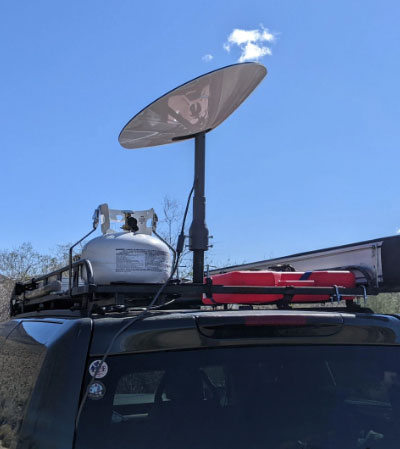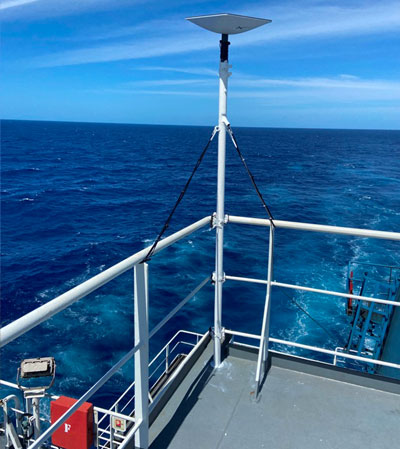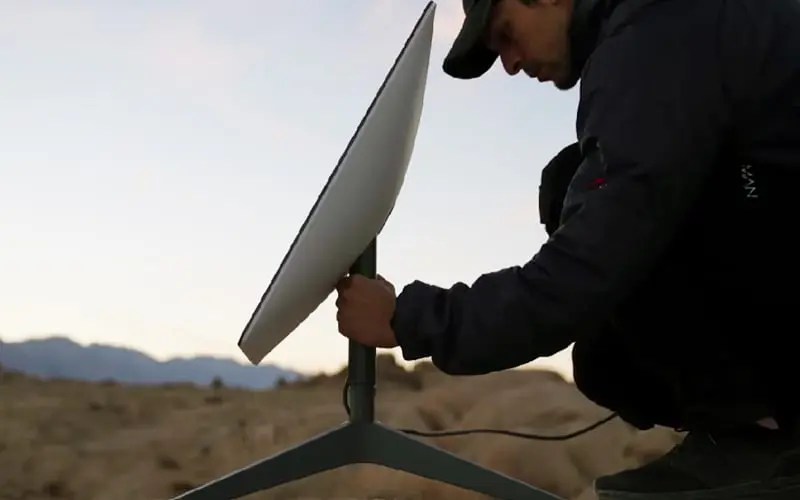Set up Satellite Home Internet
Fast Internet Services
Access & Security Solutions
How Does Satellite Internet Work?
Satellite internet works by beaming your data up into space, bouncing it off satellites, and sending it back down to Earth — letting you get online even in places where cables or cell towers can’t reach.
The Key Players
-
Your Equipment – A dish (antenna) and a modem at your home, boat, RV, or business.
-
Satellites – Machines in orbit acting as relay stations.
-
Ground Stations – Facilities on Earth connected to the high-speed fiber backbone of the internet.

The Journey of Your Data
-
You request something
You click “play” on a video. The signal goes from your device → modem → satellite dish. -
Up to the satellite
The dish sends your request via radio waves to a satellite in orbit. -
Down to a ground station
The satellite relays that signal to a ground station connected to the internet. -
Across the internet
The ground station forwards the request through normal internet routes to the website’s server. -
Back the same way
The server’s reply goes back to the ground station → satellite → your dish → your device.
Two Main Types of Satellite Internet
| Feature | GEO (Geostationary) | LEO (Low Earth Orbit) |
|---|---|---|
| Altitude | ~35,786 km | ~500–1,200 km |
| Latency | ~600–800 ms | ~20–50 ms |
| Speed | 12–150 Mbps | 50–250+ Mbps |
| Example | HughesNet, Viasat | Starlink, OneWeb |
Why LEO Systems Like Starlink Are Faster
-
Lower altitude → shorter travel time for data, reducing lag.
-
More satellites → nearly continuous coverage.
-
Advanced antennas → can quickly switch between satellites.
-
Laser links between satellites → data can travel through space without always returning to Earth first.
Pros and Cons
Pros
-
Works almost anywhere.
-
Great for rural/remote areas.
-
No need for wired infrastructure.
Cons
-
Needs clear sky view.
-
Weather can affect signal.
-
Hardware cost is higher than cable internet.
If you want, I can also draw you a visual diagram of how the signal travels between you, the satellite, and the ground station so you can see the process at a glance. Would you like me to make that?
Our Services

Residential

Roam

Boat
Why Is Satellite Internet Important
Satellite internet is important because it solves a problem that no other technology fully can: bringing reliable internet access to places where cables, cell towers, or fiber lines don’t (and may never) reach.
1. Connects the Unconnected
Global reach: Works almost anywhere with a clear view of the sky—mountains, islands, deserts, polar regions.
Bridges the digital divide: Over 2.5 billion people worldwide still lack reliable internet. Satellite internet can connect schools, clinics, and communities in remote areas.
Disaster recovery: When earthquakes, floods, or storms wipe out local infrastructure, satellite internet can restore communication quickly.
2. Critical for Mobility
Maritime: Cargo ships, fishing boats, cruise liners, and yachts rely on satellite internet far offshore.
Aviation: Passenger planes use satellites for inflight Wi-Fi and operational communications.
RVs & Expeditions: Travelers can stay connected while constantly moving.
3. Resilient Infrastructure
Independent from ground cables: If fiber lines are cut or cell towers go down, satellites still work.
Useful for military & government: Secure, redundant communications in conflict zones or remote bases.
4. Supports Modern Services
Remote work & education: Lets people join video calls, submit assignments, and access online resources from anywhere.
Telemedicine: Doctors can diagnose, consult, and monitor patients in rural clinics in real time.
Economic growth: Enables e-commerce, tourism, and business operations in previously isolated locations.
5. Drives Technological Innovation
New LEO constellations like Starlink are pushing the boundaries of speed, latency, and coverage.
Competition between satellite providers is lowering costs and making high-speed connections possible even in developing regions.



What Myths Surround Satellite Internet Use?
There are quite a few myths about satellite internet—many left over from the days of older, slower geostationary systems.
Here are the most common myths and the reality behind them:
Satellite internet is always slow.”
-
Myth origin: Older GEO providers (like HughesNet or Viasat in early 2010s) often delivered under 20 Mbps.
-
Reality: Modern Low Earth Orbit (LEO) systems like Starlink can exceed 200 Mbps, with latency low enough for online gaming and HD video calls.
“It has a huge lag—you can’t game on it.”
-
Myth origin: GEO satellites sit ~35,786 km up, causing ~600–800 ms latency.
-
Reality: LEO satellites (500–1,200 km) typically have 20–50 ms latency—similar to 4G mobile and fine for most games.
Bad weather makes it useless.”
-
Myth origin: “Rain fade” and heavy snow could interrupt older systems.
-
Reality: While extreme weather can still affect the signal, modern antennas, higher power, and better error correction make outages much shorter and less frequent.
“It’s only for remote villages or ships.”
-
Reality: Many suburban and rural households use satellite internet as their primary broadband—sometimes because it’s faster than the local DSL or overloaded 4G network.
“Satellite internet is too expensive for regular people.”
-
Myth origin: Maritime and aviation satellite plans can cost thousands per month.
-
Reality: Residential LEO plans now start around $50–$120/month, which is competitive with many cable or 5G home plans.
“You can set it up anywhere instantly without restrictions.”
-
Reality: Some plans are tied to a service address (e.g., Starlink Residential), and roaming or maritime use may require a different subscription tier or regulatory permissions.